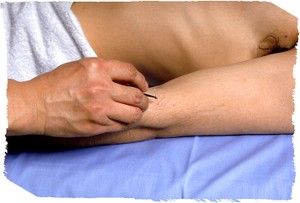Acupuncture for Hay Fever

A study from Melbourne, Australia has found that acupuncture can significantly reduce the symptoms of persistent allergic rhinitis (PAR), a.k.a. hay fever. This was a randomized, single-blind, sham-controlled trial included 80 patients with PAR aged 16-70 years, who were randomly assigned to real or sham acupuncture. Three key acupuncture points, Yingxiang L.I.-20, Yintang M-HN-3 and Fengchi GB-20, plus one supplementary point (determined individually on the basis of traditional Chinese Medicine pattern differentiation) were used for each participant. After a one-week baseline period, participants were treated twice weekly for eight weeks and followed up for another 12 weeks. Nasal obstruction, sneezing, rhinorrhea and nasal itch were each self-assessed daily on a 5-point scale, and individual symptom scores were added to give a sum of the symptom scores: total nasal symptom score (TNSS). A secondary outcome was use of PAR relief medication. At the end of eight weeks’ treatment, the weekly mean difference in TNSS from baseline was significantly greater with real (-17.2) than with sham acupuncture (-4.2) and these benefits persisted three months after the end of treatment. Comparisons of relief medication scores revealed a significant decline in the use of medication in the real acupuncture group between baseline and Week 8 of treatment, the reduction being still apparent at the end of follow-up.
This research is convincing. The effect size is not enormous, and we do not know how long the effect will last, but it does suggest another approach for people who have chronic symptoms and for whom medications are ineffective, or who do not want to take medications, or have side effects from them.
It may be relevant that some years ago it was shown that needling the Fengchi point – which lies at the base of the skull at the back of the head – increases some components of cerebral blood flow. That may give us a mechanism of action of the acupuncture in this trial.
“I am pretty sure that, if you will be quite honest, you will admit that a good rousing sneeze, one that tears open your collar and throws your hair into your eyes, is really one of life’s sensational pleasures.”
–Robert Charles Benchley (American Humorist, Critic and Parodist, 1889-1945)
“The nose is for breathing, the mouth is for eating.”
–English Proverb
“Warmth, moisture, food-these are the causes that activate latent germs and arouse them to activity. They exist, all except the food, in the mouth, nose and throat at all times. The food is thrown out into these, as excretions, in disease. The germs feed on the excretions. They are scavengers. They were never anything else and will never be anything else. They break up and consume the discharge from the tissues. This is the function ascribed to germs everywhere in nature outside the body and is their real and only function in disease. They are purifying and beneficial agents. The medical profession has worked itself into hysteria over the germ theory and is using it to exploit an all too credulous public. Germs are ubiquitous. They are in the air we breathe, the food we eat, the water we drink. We cannot escape them. We can destroy them only to a limited extent. It is folly to attempt to escape disease by attempting to destroy or escape germs. Once they are in the body, the physician has no means of destroying them that will not, at the same time, destroy the patient. We cannot avoid germs. We must be proof against them. We have to accept them as one of the joys of life.”
–Herbert Shelton (English Evolutionary Philosopher, 1820-1903)






